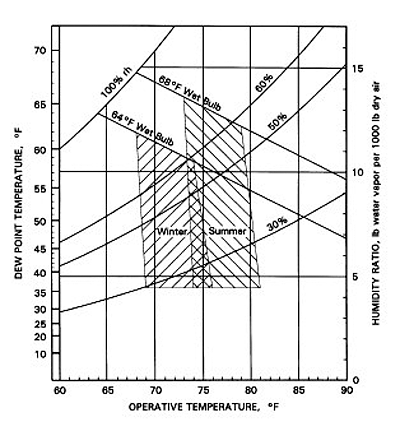
Then I graduated and the economy was slow. On top of that, let's just say I wasn't anywhere near magna cum laude, and my options were limited. So I went back to the consulting firm, but promised myself I would do something more with my life as soon as the opportunity came.
Fast forward nearly 20 years and I'm still in HVAC ... but I'm OK with that, really.
So either I've morphed into Willy myself and I'm in full denial, or perhaps I just didn't have a clue back then. Or more likely, it's a little of both, which would confirm once again that my lovely wife really got a bum steer. But let's set aside Mrs. Dickens' charity work for now and focus instead on the possibility I may be satisfied because, in fact, HVAC is as challenging and relevant as any engineering practice out there.
One of the primary reasons that what we do seems to matter more lately, is the heightened interest in sustainability, and a big piece of sustainability relates directly to indoor environmental quality (IEQ).
LEED® Points Ahead ... Proceed with Caution
In LEED® NC Version 2,1there are two prerequisites and 15 possible points associated with IEQ. Both prerequisites and eight of the 15 points are related to HVAC, and of these, a properly designed and applied underfloor air distribution (UFAD) system can directly impact or assist in obtaining the following credits:- EQc2 - Ventilation Effectiveness;
- EQc6.2 - Controllability of Systems: Non-Perimeter Spaces; and
- EQc7.1 - Thermal Comfort: Compliance with ASHRAE 55-1992.
But be cautioned. I am not advocating a system type for LEED's sake. No system type, including UFAD, guarantees LEED points. Points come from complying with standards and procedures that demand an integrated approach to the systems design.
So, while UFAD as a part of a larger strategy can contribute to the LEED score, UFAD doesn't mean you have points in the bank. Further, applying UFAD solely because of the LEED checklist is shortsighted and wrongheaded.
It may seem that I am belaboring the obvious to say that a system has to be selected based on the load, the endusers' requirements and expectations, the building geometry, and the local climate. But how many of us know of or have heard of UFAD systems that were hyped for their LEED worthiness, only to later hear they are coming up short of expectations, or worse, they are creating problems?
For UFAD to be successful, it has to be the right system for the project!

Case in Point
A few months ago, I was participating in the early stages of design for a modern operations and data center. The project had a LEED goal of Certified with fingers crossed for Silver. As we went down the LEED checklist shopping for possible points, I didn't practice what I just preached, and I suggested UFAD in an effort to get some of the points listed above.The owner's engineer expressed some discomfort with the idea of UFAD, in that he had not had a project where it had been applied, nor had he seen it applied successfully. So I disengaged from point-shopping mode and became an engineer again, and suggested that we revisit the topic offline before committing.
By the way, this point-shopping mode I speak of is so dangerous and yet such an easy trap to fall into, especially if the person facilitating the LEED discussion isn't really into sustainability. This is what can happen when LEED is forced unnaturally onto a design team.
In order to check off some LEED box on a form, we can find ourselves gaming the system instead of taking a more organic approach to the design. Consequently we create a less than ideal building. It's a sort of "legislating morality" argument that I won't go into here, but something to think about next time you hear about some city council adopting a mandatory LEED requirement. But back to our story, already in progress ...
When the engineer and I sat down to talk, the following salient points stood out:
So physically the building called for UFAD: raised floor, no visible ductwork, and a high expected rate of churn, hence the plug-and-play request. But from an IEQ standpoint, there were pluses and some possible minuses, and I had some homework to do.
First, the Good News - Personal Control
In the quest for a higher quality of life, there has been a significant amount of research that appears to support the idea that having control over one's environment contributes to higher satisfaction and increased productivity. 1,2,3,4Some of these studies have been based on more flexible yet more complex task/ambient conditioning (TAC) systems, which are not by definition UFAD systems. In fact, TAC systems such as Johnson Controls' Personal Environments product line (www.jci.com) or Argon's APACS (www.argonair.com) (Figure 1) can be fed from above or below the floor.
But what is relevant to our discussion is that with most approaches to UFAD, direct control over one's temperature and ventilation can be achieved. In turn, not only can part of the requirement for LEED credit EQc6.2 be met (lighting control is the other part), but more importantly, the intent of that point is honored: Creating a sense of empowerment in the workplace.
Honestly, I'm not sure I need a research paper to believe in the value of control (or perceived control) over one's environment. As I type away at my desk, the comforting white noise and slight breeze of an unsophisticated desk fan helps me to focus on what I'm doing instead of my surroundings. Moreover, we have all heard tales of placebo thermostats shutting up a cranky user. These items are not always a sign of a bad HVAC design per se. Basically, they are just about being (or thinking) you're in control.
Trox (www.troxusa.com), Price (www.price-hvac.com), Nailor (www.nailor.com) and York (www.york.com) are just some of the manufacturers of relatively simple and straightforward diffusers and terminal units designed specifically for UFAD. With each of these manufacturer's products, simple manual adjustments can be made by the office occupant to redirect or vary flow.
Accordingly, whether your UFAD system is ducted or unducted, a positive pressure plenum with passive diffusers or neutral pressure with fan terminal units, the common denominator is air distributed throughout the floor plate at floor level that can be controlled. And that's a good thing.

A Thermal Comfort Bonus
All this talk of personal control leads us to ASHRAE Standard 55-1992. Turns out that personal control not only affects productivity, but it also affects the way thermal comfort is calculated. And to garner LEED credit EQc7.1, one must demonstrate compliance with the standard.To a large degree, compliance with the standard boils down to the winter and summer comfort zones in the psychrometric chart we have all seen, and hopefully applied before (Figure 2). But perhaps you didn't know that these comfort zones are based on a 10% dissatisfaction criterion. And furthermore, compliance with the overall standard is based on a 20% dissatisfaction criterion.
That means 20 out of 100 people can be uncomfortable and you have still met the standard! Now I would like to think that only ticking off 20% of the building occupants is a relatively high threshold, and most designs won't exceed it. So arguably, credit EQc7.1 could be considered relatively low-hanging fruit when hunting for points.
But get this. You can actually bump the upper temperature limit of Figure 1 by as much as 5.4°F if you provide a means for the occupant to control the local air speed (Figure 3). Now, I personally wouldn't suggest that you actually design to these conditions. However, I would offer that by providing the local control UFAD can afford, you have opened your thermal comfort window a bit wider, in turn making compliance with the standard that much easier.
On the flip side, the standard is more than just Figure 2. It also puts limits on what it calls nonuniformity, which includes restrictions on vertical air temperature differences, floor temperatures, and maximum drafts. The designer should be cautioned that the standard cuts both ways on UFAD, so the supply temperature plus the location and type of diffusers used is critical to ensure uniformity and, in turn, compliance.
With this in mind, an excellent source for proper design of UFAD systems can be found in the UFAD Design Guide published by ASHRAE and authored by Fred Bauman of the Center for the Built Environment (CBE). The CBE also maintains an excellent website which can be found at www.cbe.berkeley.edu/underfloorair.
The Nitty Gritty
OK. So I have given you a number of the possible positives with UFAD. But let's go back to my case study, and the engineer's particular concern that a UFAD system could lead to dust problems and IEQ concerns.First, it's important to distinguish that not all UFAD systems are the same. So some of the perceptions about dust can be remedied with variations on the UFAD theme, such as a fully ducted system, filtered terminal units, etc., without tossing the scheme altogether. But for the sake of our discussion, and because many believe that there are inherent benefits to unducted UFAD systems, we will focus on them.
Second, while UFAD is a lot of things, it is not displacement ventilation by definition. So all of the documented benefits and in some cases concerns5 and advantages of true displacement, especially as they apply to pollutants and stratification in the space, do not apply with UFAD.
Based on the preponderance of the current evidence, the dust conundrum appears to be more intuitive than scientific. For most of us, it just seems logical that air delivered through a plenum and diffusers that are stepped on, and swept and vacuumed over, has to be dirtier than air delivered through ceiling diffusers where the effect of gravity on dirt is working in our favor.
In addition, many people think of raised floor plenums like the more common ceiling plenums that have traditionally been used for return air for decades. If you have ever popped a ceiling tile you know that return plenums are ugly places typically full of dust, and you have to thank your lucky stars that that air is heading back to the filters instead of into the space.
Dust in the Hole
Let's look at the dusty plenum paradigm first. A classic return plenum above the ceiling will always be dirtier than a raised floor plenum, if for no other reason than the air passing through it is unfiltered. In addition, just as supply ducts have to be cleaned, plenums should be cleaned as well.Now a lot of folks counter that cleaning a duct is easier than cleaning a plenum. I guess it all depends on your perspective. In either case, one usually would hire a specialist, and there are plenum-cleaning specialists out there who have served the data center market for years.
Still, duct cleaning in my experience has always been cumbersome because of limited access and working overhead. With a plenum below your feet, you are right there. Sure, you can't lift every tile, but you don't need to.
So, what if dust is in the plenum? Well, think again about that return plenum. Why is there dust standing on the ceiling tile? Because the air velocity is not great enough to carry it away. Similarly, because the velocities in the underfloor plenum are relatively low, the dirt will not be entrained.

Dust Fountains?
"But Kev," you implore, "How about at the diffusers where the velocities are certainly higher?"The mental image that is often conjured is that of multiple dust fountains throughout the space, spewing allergens into the atmosphere. But real world tests have shown that floor diffusers do not blow any more dirt into the space than overhead systems, and in at least one example actually resulted in both a lower concentration of mass and total number of airborne particles.6
In this same study it was clearly demonstrated that, in fact, the measured ventilation effectiveness showed that the ventilation performance of the UFAD system was superior to the overhead system. And isn't ventilation effectiveness really what it's all about?
Think about it. To comply with ASHRAE Standard 62.1-2004, most of us apply the prescriptive Ventilation Rate Procedure, which although slightly altered in the latest version of the standard, still boils down to outdoor intake rates dictated by use, occupancy, and area. What drives these rates is the belief that with sufficient dilution, pollutants, including dust, will be controlled to healthy levels.
You are allowed to use the prescriptive rates straight from the standard as long as the zone air distribution effectiveness for your system type is equal to 1.0. Beat 1.0, as with true displacement, and you can bring in less air. Fall short of 1.0, and you have to bring in more.
If you look at Table 1, you will quickly see that you can meet the minimum requirements with a UFAD system as we have described or with a properly designed overhead system. Bottom line: Regardless of the perception that UFAD is a dirtier system, the reality is that it is no better - and more importantly, no worse - than an overhead system when judged by the industry's standard. For me, Table 1 settles the issue.
Conclusion
HVAC has become more relevant as sustainability (and LEED in particular) has gained prominence. LEED has driven many to consider and even apply UFAD when it wasn't appropriate, plus there are concerns regarding UFAD in general and its relationship to IEQ in particular. And our natural intuition seems to tell us that it has the propensity to be a dirtier system than an overhead system.But if the building can truly support UFAD as the system type, and if great care is taken in the design, then this author contends UFAD is actually a bigger contributor to a healthy and productive indoor environment than other system types. And this belief is supported by much of the current research and industry standards.
Granted, there are a lot of folks on the fence, and some are encouraging others to stand by until further notice. But I'm reminded of a country song whose lyrics instruct, "You've got to stand for something or you'll fall for anything." Well, I guess I choose to stand for UFAD as a viable system type, especially as it relates to IEQ.
And unlike back in college, this time I know I'm absolutely right ... but check with me again in 20 years, just in case. ES
Bibliography ANSI/ASHRAE Standard 62.1-2004, Ventilation for Acceptable Indoor Air Quality. Baumann, F., Underfloor Air Distribution (UFAD) Design Guide, American Society of Heating, Refrigerating and Air-Conditioning Engineers, Atlanta: 2003.


